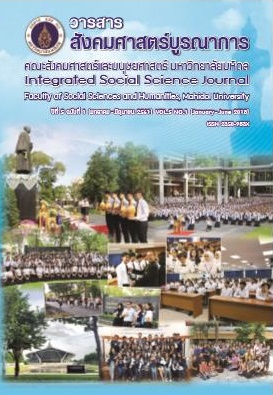Relationship between Communication and Support from the Society within the Organization and Working Morale : A Case Study of Supportive Staff of Mahidol University
Main Article Content
Abstract
This research aims to study the communication behavior, social support and work morale; study the relationship of communication behavior and work morale, and study the relationship of social support and work morale. The sample in this study included 362 supportive staff of Mahidol University, select with simple random sampling and determine the sample size via Taro Yamane formular with α = 0.05, the sample is selected from each affiliation with stratified sampling and select the sample to include all affiliation. The data was collected using the structured questionnaire with the reliability of 0.98, and analyze the data using the frequency, percentage, average, standard deviation, t-test, F-test, and Pearson’s product-moment correlation at p = 0.05. It was found that:
- The overall level of communication behavior of the participants is in a high level (3.50). Considering each aspect, the horizontal communication, downward communication and diagonal communication levels are high (average value of 3.75, 3.49, and 3.45, respectively), while the upward communication level is medium (3.29).
- The overall level of social support level of the participants is in a high level (3.40), and when each aspect is considered, both the support from colleagues and support from supervisors are in a high level (3.49 and 3.31, respectively.)
- The overall level of work morale of the participants is in a high level (3.47), when each aspect is considered, the levels of affiliation engagement, work satisfaction, security, and career progression are high (3.54, 3.52, 3.46, and 3.34, respectively).
- Personal factors, which include gender, age, education, work period, and personnel status significantly affect the work morale at p=0.05.
- Communication behavior within the organization and work morale has a moderate positive relationship (r=0.456) at p = 0.05.
- Social support within the organization and work morale has a moderate positive relationship (r=0.488) at p = 0.05.
Article Details
- Under a CC Attribution-NonCommercial-NoDerivatives 4.0 (CC BY-NC-ND 4.0) license, you can copy, distribute, display, perform, and use any published material (figures, schemes, tables or any extract of a text) for any purpose other than commercially (unless you get permission first).
- Any opinions and views expressed in this publication are the opinions and views of the authors, and are not the views of or endorsed by the journal (including the editor, any member of the editorial team or editorial board, and any guest editors).
- The editor has the right to edit the content of the manuscript to make it suitable for publication.
References
ชัยทวี เสนะวงศ์. (2547). การจัดการทรัพยากรมนุษย์เชิงกลยุทธ์. ค้นวันที่ 26 มีนาคม พ.ศ. 2561 จาก http://www.consultthai.com.
จริยาวัตร คมพยักฆ์. (2531). แรงสนับสนุนทางสังคม : มโนทัศน์และการนำไปใช้. วารสารพยาบาลศาสตร์. 6(1) กรุงเทพมหานคร.
จำเนียร สาระนาค. (2516). มนุษยสัมพันธ์ในธุรกิจเบื้องต้น. หัตถ์ศิลป์. กรุงเทพมหานคร.
ธงชัย สันติวงษ์. (2533). องค์การและการบริหาร การศึกษาการจัดการแผนใหม่. สำนักพิมพ์ไทยวัฒนาพานิช. กรุงเทพมหานคร.
ธีรวุฒิ เอกะกุล. (2543). ระเบียบวิธีวิจัยทางพฤติกรรมศาสตร์และสังคมศาสตร์. สถาบันราชภัฏอุบลราชธานี. อุบลราชธานี.
บุญรักษ์ ยอดเพชร. (2539). ความสัมพันธ์ระหว่างพฤติกรรมการติดต่อสื่อสารของผู้บริหารโรงเรียนและขวัญกำลังใจของครูในโรงเรียนประถมศึกษา สังกัดสำนักงานการประถมศึกษาจังหวัดหนองคาย. วิทยานิพนธ์ปริญญามหาบัณฑิต มหาวิทยาลัยขอนแก่น. ขอนแก่น.
เบญจพร ยิฐธรรม. (2553). ความสัมพันธ์ระหว่างพฤติกรรมการติดต่อสื่อสาร และการสนับสนุนทางสังคมในองค์การ กับขวัญกำลังใจในการปฏิบัติงาน กรณีศึกษา ข้าราชการสังกัดกระทรวงอุตสาหกรรม. วิทยานิพนธ์วิทยาศาสตรมหาบัณฑิต (การพัฒนาทรัพยากรมนุษย์ในองค์การ) คณะพัฒนาทรัพยากรมนุษย์ สถาบันบัณฑิตพัฒนบริหารศาสตร์. กรุงเทพมหานคร.
ผุสดี สัตยามานะ. (2520). การบริหารรัฐกิจ. โรงพิมพ์มงคลการพิมพ์. กรุงเทพมหานคร.
ผ่องพรรณ ตรัยมงคลกูล และ สุภาพ ฉัตราภรณ์. (2541). การออกแบบการวิจัย ประชาชน. กรุงเทพมหานคร.
พรนพ พุกกะพันธ์. (2545). ภาวะผู้นำและการจูงใจ. จามจุรีโปรดักท์. กรุงเทพมหานคร.
ภิญโญ สาธร. (2516). หลักการบริหารการศึกษา. ไทยวัฒนาพานิช. กรุงเทพมหานคร.
มัลลิกา ต้นสอน. (2544). พฤติกรรมองค์การ. ด่านสุทธาการพิมพ์. กรุงเทพมหานคร.
สมชาย หิรัญกิตติ และคณะ. (2542). องค์การและการจัดการ. Diamond in Business World. กรุงเทพมหานคร.
สมพงศ์ เกษมสิน. (2521). การบริหาร. ไทยวัฒนาพานิชย์ จำกัด. กรุงเทพมหานคร.
สมพงศ์ เกษมสิน. (2523). การบริหารงานบุคคลแผนใหม่. ไทยวัฒนาพนิช. กรุงเทพมหานคร.
สมยศ นาวีการ. (2522). การบริหาร. ดวงกมล. กรุงเทพมหานคร.
สมยศ นาวีการ. (2544). การติดต่อสื่อสารขององค์การ. บรรณกิจ 1991 จำกัด. กรุงเทพมหานคร.
สุปัญญดา หุ่นแก้ว. (2548). ความสัมพันธ์ระหว่างรูปแบบพฤติกรรมการสื่อสารภายในองค์การกับขวัญในการปฏิบัติงานของข้าราชการสังกัดกระทรวงพาณิชย์. สารนิพนธ์ปริญญามหาบัณฑิต สถาบันเทคโนโลยีพระจอมเกล้าพระนครเหนือ. กรุงเทพมหานคร.
สุรางค์ จันทน์เอม. (2529). จิตวิทยาสังคม. อักษรบัณฑิต. กรุงเทพมหานคร.
เสนาะ ติเยาว์. (2543). การบริหารงานบุคคล. โรงพิมพ์มหาวิทยาลัยธรรมศาสตร์. กรุงเทพมหานคร.
สำนักงานคณะกรรมการพัฒนาการเศรษฐกิจและสังคมแห่งชาติ สำนักนายกรัฐมนตรี. (2559). แผนพัฒนาเศรษฐกิจและสังคมแห่งชาติ ฉบับที่ 12 (พ.ศ. 2560-2564). กรุงเทพมหานคร.
อรุณ รักธรรม. (2526). พฤติกรรมองค์การ. โอเดียนสโตร์. กรุงเทพมหานคร.
อารี เพชรผุด. (2530). มนุษย์สัมพันธ์ในการทำงาน. เนติกุลการพิมพ์. กรุงเทพมหานคร.
อุทัย หิรัญโต. (2520). ศิลปศาสตร์ของนักบริหาร. โอเดียนสโตร์. กรุงเทพมหานคร.
Allen. Richard K. (1997). Organizational Management Thtough Communication. Harper & Row Publishers.
Cronbach, Lee J. (1984). Essential of Psychological Testing. 2nd ed., New York : Harper and Row.
Ferguson, George A. (1981). Statistical Analysis in Psychology and Education. 3rd New York : McGraw-Hill Book Company.
Thoits, P, A. (1982). Concequal and Theoretical Problem in Studying Social Support as a Buffer Against Life Stress. Journal of Health and Behavior. 23 (June)

